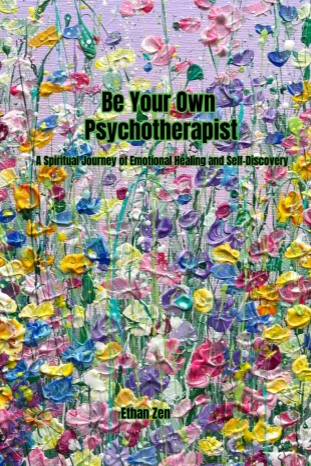Zen Meditation Practice and Enlightenment
What exactly is “Zen”? In fact, “Zen” is beyond language and words. If it can be explained with language and words, it is not Zen. If we were truly discussing Zen, I should step down as soon as I step up on the platform. This is because Zen can only be understood, not transmitted through words. Once it is written or spoken, it becomes meaningless.
However, I have to speak, because in Zen, there is a metaphor of “pointing at the moon”: for someone who has never known what the moon is, in the vast starry sky, not knowing which one is the moon, they need someone who knows the moon to point and say, “That is the moon!”
Therefore, language and words are just tools for pointing. True “Zen” is to be understood through one’s own experience.
If I am the pointer at this moment, then, I ask you all: where is the moon?
“It’s everywhere.” (Audience response)
“Wrong!” (Author’s response)
“On the thirtieth floor.” (Audience response)
“This answer is also wrong, because as soon as you have a thought, it’s wrong, and speaking is wrong!” (Author’s response)

II. Basic Concepts of Zen Studies
1. “The Buddha’s words are rooted in the mind, and the gateless gate is the Dharma gate.” – The Lankavatara Sutra
The first sentence means that the Buddha’s teachings tell us that everything is rooted in the mind, and every word flows from a pure mind; language is false, and only the mind is true and unchanging.
The second sentence points out that to reach the realm of enlightenment and seeing one’s true nature, one should use the “gateless gate” as the method of entry. The “gateless gate” means there is no specific path; just as some schools do not have a specific gate, to enter the campus, there are many ways, not necessarily through a specific gate.
During the Song Dynasty, there was a collection of koans compiled by Master Huaihai called the “Gateless Gate,” which recorded stories of enlightenment achieved through the gateless gate. Those interested can refer to it.
2. “My Dharma gate, from the beginning, first establishes non-thought as the foundation.” “The non-thought is without dual characteristics, without the mind that is polluted by various dust.” – The Platform Sutra of the Sixth Patriarch
Everyone can find a suitable path for themselves, but first, one must grasp a principle: internally, there should be no fixed views, no attachments; externally, there should be no discrimination. This state is called “non-thought.”
Non-thought does not mean the absence of thoughts, but that the “mind” is not bound by the self internally and is not shaken by the environment externally. With this as a basis, one can find a path of practice.

3. “My Dharma gate, from the beginning, gives rise to eighty-four thousand wisdoms.” – The Platform Sutra of the Sixth Patriarch
Zen studies are different from general worldly studies. General studies, even philosophy, rely on one’s own thinking and the accumulation of knowledge and experience. “Zen,” on the other hand, requires letting go of all internal and external knowledge and views before one can stimulate an unconditioned true wisdom, which is enlightenment.
Therefore, some people argue that the most foolish and lazy people should learn Zen, because Zen does not require worldly wisdom or intellectual acumen, nor does it demand extensive knowledge and memory.
Conversely, others believe that only those with great wisdom are qualified to study Zen. People with great wisdom can absorb and let go at any time, thus constantly renewing themselves. Only such people are likely to attain enlightenment.
4. “The world’s wonderful nature is originally empty, and there is no method to obtain it.” – The Platform Sutra of the Sixth Patriarch
Generally, those seeking the Way and studying the Dharma always believe that the “Way” or the “Dharma” is a real thing. Zen, however, requires one to break through this conceptual cage and directly point to the original mind. Zen believes that there is nothing outside the mind.
5. “Apart from nature, there is no separate Buddha.” “Seeing one’s nature is becoming a Buddha.” – The Platform Sutra of the Sixth Patriarch
Chinese Zen particularly emphasizes the enlightenment of seeing one’s nature. However, what is “one’s nature”? Master Huineng, the Sixth Patriarch, said, “Bodhi is the original nature, inherently pure, but using this mind, it becomes Buddha.” He also said, “When the previous thought is deluded, one is an ordinary person; when the later thought is awakened, one is a Buddha.” This indicates that the difference between a Buddha and an ordinary person lies in the former’s awakening and the latter’s delusion. If one can reach the state of “non-thought, non-memory, non-attachment, with freedom inside and out,” then it is “seeing one’s nature and becoming a Buddha.”

III. How does Zen practice?
1. Sitting quietly is not Zen, and sitting in a daze will not lead to enlightenment
Before his enlightenment, Shakyamuni Buddha sat under the snow-covered mountain for six years, and when Bodhidharma, the Patriarch of Zen, first arrived in China, he also faced a wall for nine years on Mount Song. This shows the importance of sitting meditation. However, the early Chinese Zen masters still followed the traditional Indian method, placing great emphasis on sitting meditation. This continued until the time of Huineng, especially during the time of Huai Rang of Nan Yue, when a change occurred, emphasizing enlightenment rather than fixation.
There is a case that represents this change. When Master Huai Rang sat down, Master Ma Zu asked him, “Why are you sitting?” Huai Rang replied, “I don’t know.” Ma Zu said, “If you don’t know, why are you sitting?” This story emphasizes that enlightenment lies in letting go of self-attachment. Sitting is only beneficial when the mind is free from turmoil. Sitting for a long time is pointless if the mind is still filled with restless thoughts or is like a ghost dwelling in a dark cave, doing nothing.
2. When sitting quietly, being aware of the arising of afflictions in the mind is practice
The Lankavatara Sutra says, “Knowing that it is an illusion… is to be free from it… being free from it is enlightenment.” However, it is also important not to resist afflictions. The goal is enlightenment, not to seek peace and avoid trouble.
3. Everyday life is Zen practice
Zen has a story about a monk who went to Master Zhao Zhou to seek guidance. Zhao Zhou asked, “Have you eaten rice?” The monk replied, “Yes, I have.” Zhao Zhou said, “Then go wash your bowl.” This story illustrates that everyday activities are part of Zen practice. Zen emphasizes that practice should be integrated into daily life, with every thought and action being clear and precise. Whether it’s walking, standing, sitting, or lying down, eating, getting dressed, or interacting with others, all are part of practice.

4. Clinging to practice is not true practice, and neglecting practice is not true practice
Returning to the “polishing bricks to make a mirror” case, the story illustrates that clinging to formal practice is useless. Many people believe that practice is only about sitting in front of a Buddha, bowing, reciting scriptures, or going into seclusion in deep mountains and old caves. However, Zen emphasizes that practice should be integrated into daily life, with every thought and action being clear and precise.
5. Maintaining an even mind and an ordinary mind is practice
The Platform Sutra of the Sixth Patriarch states, “A straight mind is the Dharma realm, and a straight mind is the Pure Land.” The “straight mind” is an ordinary mind, completely free of subjective distinctions and attachments, yet possessing a transcendent and pure mind. This is a sign of a person with great wisdom. Maintaining an even mind means that at the present moment, one is in the pure land. However, achieving this state is not easy and requires continuous practice.
6. Having a clear and precise mind, not thinking of good or evil, is practice and enlightenment
During the Tang Dynasty, there was a monk who went to visit the Zen master Zhao Zhou and asked, “What is the essence of the Buddha’s teachings?” Before he could finish his question, the master hit him with a stick. This action was repeated three times. This practice is about generating great doubt, forcing delusions and wandering thoughts into a dead end, and ultimately leading to enlightenment.

IV. How does one attain enlightenment in Zen?
1. Enlightenment comes when the mind is at peace
There is a well-known case in Zen history: the Second Patriarch Hui Ke asked the First Patriarch Bodhidharma, “What is the essence of the Buddha’s teachings?” Bodhidharma replied, “The essence of the Buddha’s teachings cannot be obtained from others.” Hui Ke said, “My mind is not at peace; please help me find peace.” Bodhidharma replied, “Bring your mind here, and I will pacify it.” Hui Ke searched for his mind but could not find it, and said, “I can’t find my mind.” Bodhidharma replied, “I have pacified your mind.”
2. Enlightenment comes when the mind has no fixed abode
The most important Zen master in Chinese Zen history, the Sixth Patriarch Huineng, was enlightened by hearing a line from the Diamond Sutra. The line was, “Let your mind be unattached to anything.” Huineng realized that all phenomena are not separate from the pure nature. Before his enlightenment, he had regarded all phenomena as a source of affliction, but after his enlightenment, he saw all phenomena as tools for the practice of the Way.
3. Enlightenment comes when the mind has no desires
The Zen master Linji Yixuan went to visit the master Xiyun of Huaiji. He asked, “What is the essence of the Buddha’s teachings?” Before he could finish his question, the master hit him with a stick. This action was repeated three times. After this, Linji visited the master Dayu, and when he described the experience, Dayu said, “Xiyun is so old-fashioned; even if you had a breakthrough, you still had to suffer three blows. The old man Dayu will suffer one too.” Linji replied, “What is there to suffer? Let’s get it over with now.” He then struck Dayu. This story illustrates that enlightenment can come through various experiences.

V. The Function of Striking in Zen
1. The monk from Silla was struck by Master De Shan
A monk from Silla came to see Master Deshan. Deshan said, “No questions today!” The Korean monk bowed, and Deshan said, “Thirty blows!” The Silla monk protested, “I didn’t say anything!” Deshan replied, “You should have received thirty blows before leaving Silla!” After receiving thirty blows, the monk may or may not have attained enlightenment, as the records do not indicate.
2. Yunmen Wenyen was struck by Master Muzhou
When Yunmen Wenyen went to see Muzhou, Muzhou closed the door. Yunmen knocked on the door. Muzhou asked, “Who is it? What do you want?” Yunmen said, “I don’t understand; please enlighten me.” Muzhou opened the door, saw Yunmen, and then closed the door again. This continued until the third day, when Muzhou finally opened the door and Yunmen rushed in. At that moment, Yunmen achieved enlightenment.
3. Linji encountered blows three times
Linji Yixuan went to visit Master Huangbo Xiyun and asked, “What is the essence of the Buddha’s teachings?” Before he could finish his question, he was struck. This happened three times. Afterward, Linji visited Master Dajian Dayu, who said, “Huangbo is so old-fashioned; he’s still seeking in you!” Linji replied, “What is there to seek? Let’s get it over with now.” This story illustrates that enlightenment can come through various experiences.








